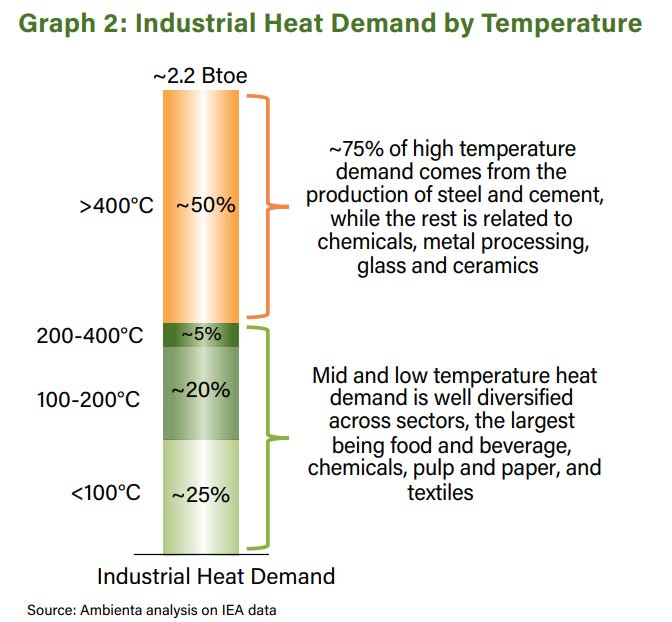Heat pumps on the factory floor
Heat is the backbone of any industrial process.
Melting the steel that we need to build our bridges and trains, firing the cement kilns that provide the building blocks to construct our houses and offices, and the factories that heat the ceramics and glassware that we eventually eat and drink from.
Industrial heat accounts for ~20% of global energy demand. Around three-quarters of that heat is supplied using fossil fuels, primarily natural gas and coal and contributes around 10% of global greenhouse gas (GHG) emissions. In addition, industrial heat generates air and soil pollutants such as NOx, SOx and particulate matter.
It’s no wonder that industrial heat demand is a focal point for decarbonisation and pollution control.
Temperature matters, a lot. The products that we commonly think of when it comes to industrial heat applications include steel, cement, glass and ceramics. Industries such as these require high temperatures (more than 400 °C, and over 1,000 °C for metal smelting) and account for about half of global industrial demand for heat.
However, there are a vast number of other industries that need heat to manufacture, but typically require significantly lower temperatures. As the chart below shows, one quarter of industrial heat demand is for temperatures below 100 °C, and includes industries such as food, paper and textile manufacture.
Analysis examining the options available to decarbonise industry tends to focus on the high temperature manufacturing processes - steel, aluminium, cement, etc. Solutions tend to centre on investing in electric arc furnaces, hydrogen-based direct reduction ironmaking (H-DRI), powering aluminium smelters using nuclear or hydropower, and replacing natural gas with biomethane (see here, here, and here). Many of these technologies are expensive, time consuming to implement, and untested on a commercial scale.
There is a technology that has been around for decades, one that has been used in many peoples homes that could offer an immediate solution to decarbonising industrial heat demand for those manufacturing sectors that rely on low temperature heat demand.
It probably hasn’t escaped you that heat pumps are getting a lot of attention at the moment. Although the technology was invented as far back as the 1850’s, they are increasingly being installed in homes to decarbonise residential heating. Much less well known is that there is a growing market for much heat pumps in difficult to decarbonise industrial sectors that use a lot of low temperature heat.





